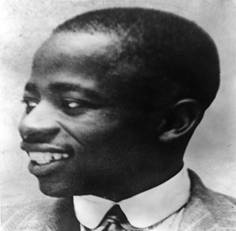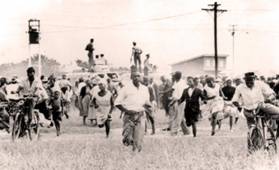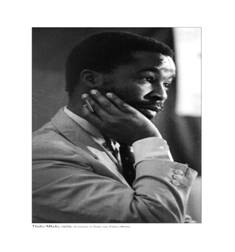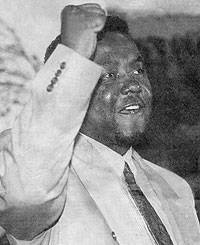The African National Congress Youth League (ANCYL) was established on 2 April 1944, by Anton Lambede (who became the League’s first President), Nelson Mandela, Ashby Mda, Walter Sisulu and Oliver Tambo. They were joined by, Duma Nokwe, B Masekela, Ida Mtwa, Lillian Ngoyi, James Njongweni, William Nkomo and Dan Tloome.
The aim of the Youth League was to galvanise the youth to step up the fight against segregation within the country. At the time the ANCYL was established, political circumstances in South Africa were tenuous as the ruling United Party was divided about South Africa’s participation in World War II. Four years after the establishment of the Youth League, the United Party’s rule came to an end and the country was subsequently governed by the National Party.
The emergence and growth of the Youth League
The Youth League’s manifesto was launched at the Bantu Social Centre in Johannesburg in March 1944 ahead of its inaugural meeting. It stated, amongst others, that Africanism should be promoted (i.e., Africans should struggle for development, progress and national liberation so as to occupy their rightful and honourable place among nations of the world); and that the African youth should be united, consolidated, trained and disciplined, because from their ranks, future leaders would be recruited. Their motto was: “Africa’s cause must triumph”.
 Anton Lambede, the first ANCYL President. Source: sahistory.org.za [Accessed: 05 January 2012]
Anton Lambede, the first ANCYL President. Source: sahistory.org.za [Accessed: 05 January 2012]
To strength its fight for liberation, the Youth League developed a Programme of Action which involved different methods like boycotts, strikes and other defiance tactics. In 1949, the ANC adopted this programme, which represented a radical departure from the ineffective strategies of the past, and a transformation of the organisation into a revolutionary mass movement. In the next decade, this change of policy would lead to the Defiance Campaign and the Congress of the People.
During the 1950s the National Party (NP), which came into power in 1948 introduced harsh and oppressive laws towards blacks. In 1952, adoption of the Youth League’s Programme of Action became apparent in both the organisation and execution of the Defiance Campaign. The ANC, the South African Indian Congress (SAIC) and the South African Communist Party (SACP) embarked on the campaign in an attempt to make the country ungovernable and force the apartheid regime to abandon its oppressive policies. Similar campaigns targeting specific apartheid laws such as the Bantu Education Act and the Group Areas Act were undertaken. Furthermore, in many of these campaigns, the influence of the ANCYL was significant. Although the programme initially led to the hardening of Government attitude, in the end the apartheid government had to concede that its policy of racial segregation was unsustainable.
At the Congress of the People held in Kliptown on 26 June 1955, the Freedom Charter, spelling out the people’s vision of the kind of South Africa they desired, was adopted. This document would eventually become the basis of a democratic constitution hailed as one of the most progressive in the world.
Members of the ANCYL continued to be conspicuous and prominent in national campaigns during the 1950s. However, the adoption of the Freedom Charter sowed divisions within the ranks of the ANCYL. A group of “youth leaguers”, led by Robert Sobukwe and Ashley Peter Mda condemned the Freedom Charter as promoting the ideals of the Congress Alliance and ignoring the stated objectives of the Programme of Action. Other members of the ANCYL who had embraced the Freedom Charter continued to dominate the resistance campaign.
The decline of the ANCYL
In 1947 the ANCYL lost its most inspirational leader. Anton Mziwakhe Lembede passed away at the a very early age of 33, leaving a leadership gap that the organisation found difficult to fill. Moreover, after a brief but fervent period of political campaigns such as the Defiance Campaign, the Bantu Education Campaign and the Anti Removal campaign, in respect of the Western Areas of Johannesburg, the ANCYL went into decline. Many of its leaders were implicated in the Treason Trial that lasted from 1956 to 1959/60. In adition, in the interim, the adoption of the Freedom Charter served as the catalyst leading to a formal split in the organisation.
The “Africanist” faction in the ANCYL broke away in 1959 to form the Pan Africanist Congress (PAC) in 1959. Others, like Nelson Mandela and Walter Sisulu, remained in the mainstream ANC, assuming important leadership positions in the movement. On 21 March 1960 the PAC called for a nationwide protest march against the Pass Laws. Protest marches were held in various urban centres across South Africa. Protest marches were reported in Orlando, Langa outside Cape Town and Sharpevill near Vereeniging.
Marches in Sharpeville and Langa appear to have been better organised and supported. The march in Sharpeville ended in a massacre, leaving 69 demonstrators dead after being shot, mainly from the back, by security police. Scores were left injured and others arrested. In Cape Town’s Langa township, police baton charged and fired tear gas at protesters, killing three and injuring several others.
 Demonstrators running for their lives at Sharpeville, March 1960. Source: dailymaverick.co.za [Accessed: 05 January 2012]
Demonstrators running for their lives at Sharpeville, March 1960. Source: dailymaverick.co.za [Accessed: 05 January 2012]
Many Youth League leaders like Henry Makgothi, who was the President, were absorbed into the ANC’s National Executive Committee (NEC) or other leadership positions within the organisation. Without its leaders, the Youth League lost its momentum. Subsequently, the Youth League became moribund. Several other youth organisations, such as the South African Student Organisation, led by Steve Biko, emerged towards the end of the 1960s, taking the lead in continued resistance to apartheid.
Once in exile, the ANC elders in London asked Thabo Mbeki to launch an organisation of South African students and youth in Britain to continue resistance against apartheid. In 1964 Mbeki, Essop Pahad and others convened a meeting in London to establish the South African Students Association (SASA). SASA in London was to take a different path from the African Students Association (ASA) in South Africa as it was going to be a non-racial and non-sectarian movement. At the meeting Mbeki was elected as secretary, a PAC man was elected chairman and a White student was elected vice-chairman. Shortly after they were elected, Mbeki clashed with his superior in Dar-es-Salam, James Hadebe over SASA’s non-racialism. Hadebe instructed Mbeki to disband SASA and set up a new organisation. Mbeki declined, suggesting that youth organisations such as SASA can be used by underground ANC structures. In 1965 Mbeki drafted a political document outlining the imperatives of mobilising already-existing youth and student organisations to fight against apartheid.
 Thabo Mbeki during the 1970s. Source: www.docstoc.com [Accessed: 05 January 2012]
Thabo Mbeki during the 1970s. Source: www.docstoc.com [Accessed: 05 January 2012]
The ANC leadership accepted Mbeki’s argument and in 1966 the ANC Youth and Student Section (ANC YSS) was formed with Mbeki as leader in Britain. The ANC YSS had two main objectives: looking after the welfare of the ANC youth and mobilising youth against apartheid internationally. ANC YSS leaders would later play critical roles in the country’s transition to a democracy. They included Billy Modise, Joe Nhlanhla who would become Mbeki’s first minister of intelligence and was the chair of the ASA in Moscow, Union of Soviet socialist Republics (USSR), Jackie Selebi and many others.
In Moscow Sipho Makana was elected as the leader of the ANC YSS by the ANC headquarters in Tanzania. Manto Mali (later Tshabalala-Msimang), who would later become a health minister under Mbeki’s administration, Vera Gule, Petrus Sibande, Sindiso Mfenyane, Thabo Ragape and Max Sisulu, the son to Walter and Albetina Sisulu, were among ANC students who were in Moscow. There was a general feeling that ASA students were different from uMkhonto weSizwe (MK) recruits as they were always isolated, while MK recruits were normally in large groups in camps.
In the 1980s the mobilisation of the youth was led by the Congress of South African Students (COSAS). In 1983, after the formation of the United Democratic Front (UDF) that became home to hundreds of organisations united against the repressive apartheid regime, COSAS and Azanian Students Organisation (AZASO) formed a progressive youth alliance. Throughout the Eighties, students and youths would actively defy apartheid in the face of imprisonment, torture and murder, earning them the name “Young Lions of the Struggle”, a term coined by Oliver Tambo.
The revival of the Youth League
The ANC set up a national committee to unite all youth congresses in a National Youth Organisation. On 28 March 1987, with the country restrained by a national state of emergency imposed by the apartheid government, the South African Youth Congress (SAYCO) was secretly established in Cape Town. Peter Mokaba, a former political prisoner on Robben Island, was appointed as president of SAYCO and Rapu Molekane as general secretary. The organisation worked hard to achieve the unbanning of the ANC, and that goal became a reality in February 1990. Subsequently, the unbanning of the ANC prompted the re-establishment of the ANCYL by a Provisional National Youth Committee set up for this purpose. In 1991, the Youth League was re-launched with a view to supporting negotiations during the transition to democracy, with Peter Mokaba as president. Mokaba was in turn succeeded by Lulu Johnson, Malusi Gigaba, Fikile Mbalula and Julius Malema.
 Peter Mokaba, ANCYL President. Source: sahistory.org.za [Accessed: 05 January 2012]
Peter Mokaba, ANCYL President. Source: sahistory.org.za [Accessed: 05 January 2012]
After 1994, the League’s aims were redefined as mobilising the youth behind the ANC vision of the country’s future, and looking after their socio-economic interests. The League has come to be viewed as an influential component within the broader ANC, and providing a training ground for future ANC leaders. This role was recognised by South Africa’s current president, Jacob Zuma, who came to power on the wings of a vociferous ANCYL support.
Parallels have been drawn between the firebrand political styles of Mokaba and Malema. In one of these, a court of law warned Malema in 2010 not to sing the struggle song “Kill the boer, kill the farmer”. Mokaba had also sung the song in 1993, but the ANC under Nelson Mandela’s leadership issued a public rebuke, as this clashed with the ANC policy of racial reconciliation. Early in 2010, President Jacob Zuma also publicly rebuked Malema over his conduct that diverged from official ANC policy.
In August 2010 and again in 2011, the ANC charged Julius Malema, Youth League spokesperson Floyd Shivambu, deputy president Ronald Lamola, treasurer general Pule Mabe, secretary general Sindiso Magaqa and deputy secretary general Kenetswe Mosenogi for “sowing divisions” in the party and bringing the party “into disrepute”. Subsequently, they were found guilty by the NDC and he (Julius Malema) was suspended for five years. The League spokesman Floyd Shivambu is suspended for three years.